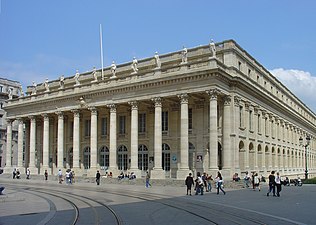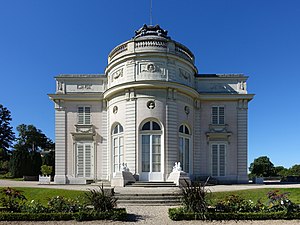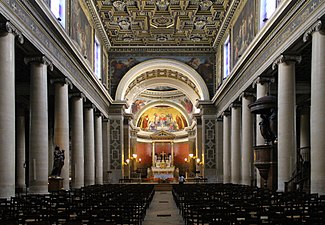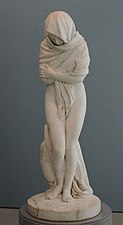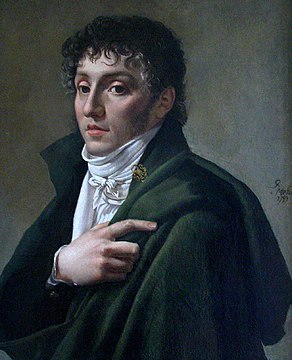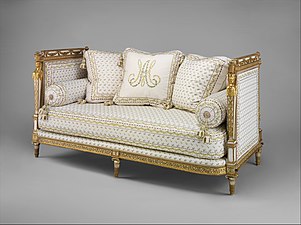Neoclassicism in France
| Years active | c. 1760–1830 |
|---|---|
| Location | France |
Neoclassicism is a movement in architecture, design and the arts which emerged in France in the 1740s and became dominant in France between about 1760 to 1830. It emerged as a reaction to the frivolity and excessive ornament of the
Prominent architects of the style included
History
Neoclassicism in France emerged in the early to mid-18th century, inspired in part by the reports of the archeological excavations at Herculaneum (1738) and especially Pompeii (1748), which brought to light classical designs and paintings. The news of these discoveries, accompanied by engraved illustrations, circulated widely. The French antiquarian, art collector and amateur archeologist Anne Claude de Caylus travelled in Europe and the Mideast, and described what he had seen in Recueil d'antiquités, published with illustrations in 1755.[2]
In the 1740s, the style began to slowly change; decoration became less extravagant and more discreet. In 1754 the brother of Madame de Pompadour, the Marquis de Marigny, accompanied the designer Nicolas Cochin and a delegation of artists and scholars to Italy to see the recent discoveries at Pompeii and Herculaneum, and made a grand tour of other classical monuments. They returned full of enthusiasm for a new classical style, based on the Roman and Greek monuments. In 1754 they published a manifesto against the Rocaille style, calling for a return to classicism. Marigny, after the death of Louis XV, later became director of buildings for Louis XVI.[3]
The style was given a philosophical appeal by the Philosophes, including
In the last years of the reign of Louis XV and throughout the reign of Louis XVI, the new style appeared in the royal residences, particularly in the salons and furnishings of the Dauphine and then Queen
Architecture
Louis XIV, Louis XV and Louis XVI
Under Louis XIV, the Roman dome and façade of monumental columns became the dominant features of important new churches, beginning with the chapel of
-
The
-
Hotel de la Marineon the Place de la Concorde (1761–70)
-
Petit Trianon (1764)
-
Interior of Church of Saint-Philippe-du-Roule, Paris (1765–70)
In the latter part of the reign of
The religious architecture of the period was also sober and monumental and tended, at the end of the reign, toward neo-classical; major examples include the Church of Saint-Genevieve (now the Panthéon), built from 1758 to 1790 to a design by Jacques-Germain Soufflot, and Church of Saint-Philippe-du-Roule (1765–1777) by Jean Chalgrin, which featured an enormous barrel-vaulted nave.[8]
-
Claude-Nicolas Ledoux(1770-1780)
-
Grand Theater of Bordeaux by Victor Louis (1780)
-
Stairway of the Grand Theater of Bordeaux, Victor Louis (1780)
-
Chateau de Bagatelle by François-Joseph Bélanger(1777)
-
TheHôtel de Salm, Paris, by Pierre Rousseau(1751-1810)
-
The Belvedere of the Petit Trianon at Versailles by Richard Mique (1789)
-
Transept of Notre-Dame de Guebwiller (1762–1785)
-
ThePantheon (1764-1790), by Jacques-Germain Soufflot
-
Interior of the Paris Pantheon
During the reign of Louis XVI, neoclassical was the dominant architectural style in Paris and in the provinces. Notable examples include the
The new theaters in Paris and Bordeaux were prominent examples of the new style. The architect
One of the best-known neoclassical buildings of the period is the
Another notable example of the neoclassical style in Paris is the
-
Director's house at theClaude-Nicolas Ledoux(1775–79)
-
Rotonde de la Villette byClaude-Nicolas Ledoux(1785–89)
-
Project for a monument to Isaac Newton by Étienne-Louis Boullée (1784)
-
Project for the Royal Library by Étienne-Louis Boullée (1785)
A few architects adapted the neoclassical style to more functional purposes.
The most visionary French neoclassical architect was certainly Étienne-Louis Boullée. His designs for an immense spherical monument to Isaac Newton (1784) and a vast new royal library in Paris in the form of a giant barrel vault (1785) were never seriously considered, but foreshadowed the architecture of the 20th century.[13]
Revolution, Directorate and Empire
During the French Revolution construction virtually stopped in Paris. The aristocrats fled, churches were closed and sacked. The one large project carried out between 1795 and 1797 was the building of a large new chamber within the
-
Church of the Madeleinefacade by Pierre-Alexandre Vignon (1807–43)
-
Arc de Triomphe by Jean Chalgrin (1808-1838)
-
Facade of the Palais Bourbon, added by Napoleon in 1808
After
Other Napoleonic neoclassical projects included the grand stairway of the
The Restoration and arrival of romanticism
After the final defeat of Napoleon in 1815, the neoclassic style continued to be used during the
A change of style began to appear early in the 19th century, particularly after the publication in 1802 of le Génie du christianisme by one of the leading figures of French
-
Notre-Dame-de-Lorette (1823–26) by Louis-Hippolyte Lebas
-
Interior of Notre-Dame-de-Lorette
-
Jacques-Ignace Hittorff(1824–44)
Painting
The dominant figure in French neoclassical painting, even before the Revolution, was
-
Oath of the Horatii by Jacques-Louis David (1781)
-
Death of Marat by Jacques-Louis David (1793)
-
Madame Récamier by Jacques-Louis David (1800)
French painting was dominated for years by David and his pupils, including
-
Emma, Portrait of Emma, Lady Hamilton as a Bacchante by Élisabeth Vigée Le Brun (1790)
-
Liberty or Death by Jean-Baptiste Regnault (1795)
-
Mademoiselle Lange as Danae byAnne Louis Girodet-Trioson(1799)
-
Portrait of Christine Boyer by Antoine-Jean Gros (1800)
-
Oedipus and the Sphinx by Jean-Auguste-Dominique Ingres (1800)
-
Portrait of Madame Récamier by François Gérard (1805)
-
Justice and Divine Vengeance Pursuing Crime by Pierre-Paul Prud'hon (1808)
Sculpture
The most prominent French sculptor in the early neoclassical period was Étienne Maurice Falconet (1716–1791). whose work included the heroic statue of Peter the Great on horseback in Saint Petersburg, Russia (model made in 1770, but not cast until 1782). He was named professor at the Academy of Fine Arts in Paris in 1766, and from 1757 onward he directed the modeling of small sculptures in porcelain at the Sèvres Porcelain manufactory. His work remained closer to the statues in full movement of the French baroque than the new, more serene style. In his later years he designed small ornamental sculptures of cast bronze such as the Seated Girl (1788), now in the Metropolitan Museum.[18]
The first more clearly neoclassical major figure was
The sculptor
Augustin Pajou (1730–1809) also studied at the French Academy in Rome from 1752 and 1756. He returned to Paris to teach at the Academy of Fine Arts, and became rector in 1792. He made a series of highly expressive statues on mythological subjects, including Psyche and Amour.
-
Bust of Voltaire by Jean-Antoine Houdon (1778), National Gallery
-
La frileuse (woman in winter), Jean-Antoine Houdon (1783)
-
Seated Girl by Étienne Maurice Falconet, in bronze (1788), Metropolitan Museum
-
Faun Family Terracotta by Claude Michel (1785), National Gallery, Washington DC
-
Mercury by Augustin Pajou (1780), Louvre
-
Bust of Madame Vigée Le Brun by Augustin Pajou (1785), Louvre
Music
The effects on Neoclassicism in art are very spotted through artworks and sculptures, but when it comes to music, it is at times overlooked. With the emergence of new ideals, and the shift towards independence from the crown, French society began to see a change in architecture and design, as well as in the arts. Their shift in music commenced the beginning of the romantic era in musical history. The revolts in France at the time, created an environment of hostility and uneasiness, forcing many opera writers to look to France's past in order to portray a sense of unification for the French commoners.[20] In many senses, these operas, and musical settings played political roles in being able to pass on political beliefs on topics, in order to evoke a greater sense of unity in the viewers, believing that many others saw the causes as they personally did.
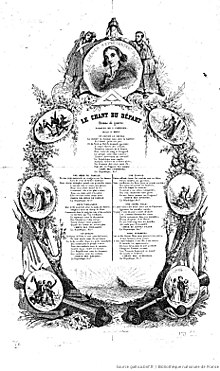
In the era of the French Revolution, particularly under the rule of Napoleon, the famous composer Étienne Méhul was known for composing many patriotic pieces for the people and nation of France. Most famous of which is Le Chant du depart, later becoming the official anthem of the French Empire in 1794. Often compared to the current national anthem of France, La Marseillaise, Le Chant du depart holds ties to the unity of the French people, as well as the diversity of French society. The points of view of those who sing range from a deputy to their soldiers, mother, wives, husbands, and fathers, depicting the roles they must take and live through during this era of revolution.[21] The grammatical composition itself from the piece generalizes the characters, for them to see each other as equals under the premise of victory and success. Banned by both Napoleon and Louis XVIII for its revolutionary ties, La Marseillaise, achieves the similar goal of uniting the people of France by evoking from them a sense of patriotism, as it was nicknamed “Chant de guerre pour l'Armée du Rhin” (War song for the Army of the Rhine).[22] Written by Claude-Joseph Rouget de Lisle, it displayed the primary aspects of neoclassical music of this era, La Marseillaise tells the story of the strength of the people and army, in this scenario of their strength against the Austrian and Prussian troops.[23] Uniting them through a renewal of both baroque and classical music,[24] it is not of the glorious history of France, but of the resilience of its people who fought, and still fight to create the nation in which they dreamed to build. Eventually being brought back as the song of the people, it was restored to its position as national anthem, as it remains to this day.
-
Manuscript of La Marseillaise
-
Portrait of Claude-Joseph Rouget de Lisle
-
Étienne Méhul (1763-1817) composed Le Chant du depart
Interior decoration
The goût Grec or "Greek taste" in design was introduced in France in 1757 by Jean-François de Neufforge in his book Recueil élémentaire d'architecture, which praised "the majestic and sober style of the architects of ancient Greece." He offered engravings of classical vaults, garlands of laurel leaves, palmettos and guilloches (braided interlaced ribbons) and other motifs which soon appeared in Paris salons.[25]
Beginning in the 1770s, the style pompéien or Pompeii style came into fashion in Paris, based on reproductions of designs found in Pompeii, augmented with
During the
-
Boudoir ofMarie-Antoinette, Palace of Fontainebleau(1790)
-
Apartment of theEmpress Josephine at the Château de Malmaison(1800)
-
Library of the Château de Malmaison, made for Empress Josephine by Percier and Fontaine (1800)
-
Napoleon's bedroom at the Grand Trianon, Palace of Versailles
The Empire Style had extraordinary coherence and audacious simplicity, thanks to Napoleon's two energetic chief designers, Charles Percier (1764–1838) and Pierre-François-Léonard Fontaine (1762–1853). The motifs were usually symbols of empire, including crowns and laurel wreaths, medals, lyres, horns of plenty, and classical heads seen in profile. Rooms sometimes had the walls draped in fabric, representing the tents of an army on campaign. Interiors and furniture often featured classical columns carved of wood. Egyptian motifs and mythical beasts from antiquity, such as the sphinx, griffon and the chimera, were popular. Imperial emblems, including the eagle, the bee, and the letter N with a crown, were also common.[27]
Furniture
The first "Greek taste" furniture in France, made in 1756 and 1757 to designs by
After the death of Oeben, his place was taken by two of his disciples,
-
Desk for Louis XV byJean-Henri Riesener(1760–69), Palace of Versailles
-
Mechanical writing table byJean-Francois Oeben(1761–63), Metropolitan Museum
-
Commode byJean-Henri Riesener(1770–80), Art Institute of Chicago
-
Armchair by Georges Jacob (1781), Palace of Versailles
-
Drop-front desk byJean-Henri Riesener(1783), Metropolitan Museum
-
Day bed by Jean-Baptiste-Claude Sené (1788), Metropolitan Museum
In Louis XVI furniture, particularly in the 1780s, the furniture styles became lighter, more geometric, and more simply ornamented, following the tastes of Marie Antoinette. The leading French designers during this period were Jean-Baptiste-Claude Sené (1748–1803) and Georges Jacob (1739–1814). At the very end of the reign of Louis XVI, Sené and Jacob were producing highly original and imaginative forms, including chairs with lyre-shaped carved wooden backs and the "Etruscan chair", a type conceived by the painter Hubert Robert for the fantasy "rural hamlet" of Marie-Antoinette at Versailles. The ornament on the chair, which remained popular long after the period ended, was borrowed from ancient Grecian vases.[29]
-
"Etruscan" chair for Petit Trianon by Hubert Robert and Georges Jacob (1787), Palace of Versailles
-
Secretaire by Bernard Molitor (c. 1800), Cleveland Museum of Art
-
Swan armchair for Empress Josephine, byChateau de Malmaison
The furniture craft was upended by the French Revolution; the aristocratic clients fled, and the furniture of the royal palaces was sold in enormous auctions; a large part went abroad. One positive development for furniture-makers was the abolition of the old guild rules; after 1791 the makers of furniture frames could collaborate with those who did the marquetry inlay. The Etruscan taste disappeared, but the neoclassic style flourished under the French Directory (1793–99), the French Consulate (1799–1804), and the Empire of Napoleon Bonaparte.
The last leading furniture designer for Louis XVI, Georges Jacob, formed a new firm with his two brothers, and, between 1796 and 1803, became the most prominent designer of the later neoclassical period. He made an effort to find classical forms that were more authentic. The type of Greek chair called the klismos became especially popular; Jacob produced a variety of neoclassical divans and stools, as well as the Lit de Repos, or day bed, which appeared in
Citations
- ^ Riley 2004, p. 126.
- ^ de Morant 1970, p. 389.
- ^ Wiegandt 2005, p. 54.
- ^ Riley 2004, p. 128.
- ^ Summerson 1963, Plate 47; Ayers 2004, pp. 36–37.
- ^ a b Summerson 1963, Plate 47.
- ^ Ducher 1988, p. 124.
- ^ a b Ducher 1988, p. 140.
- ^ a b Prina & Demartini 2006, p. 249.
- ^ Renault & Lazé 2006, p. 77.
- ^ Ducher 1988, pp. 162–3.
- ^ Toman 2007, pp. 77–85.
- ^ Toman 2007, pp. 84–86.
- ^ a b Toman 2007, p. 87.
- ^ Toman 2007, p. 101.
- ^ Toman 2007, pp. 367–79.
- ^ Toman 2007, pp. 378–396.
- ^ Toman 2007, p. 254.
- ^ Toman 2007, pp. 256–57.
- ^ Dotson, Savannah J. (Spring 2014). "French Opera and the French Revolution, Etienne Nicolas Mehul". Archived from the original on 2022-03-23. Retrieved 2022-04-12.
- from the original on 2022-04-12. Retrieved 2022-04-12.
- ^ "Internet History Sourcebooks". sourcebooks.fordham.edu. Archived from the original on 2022-04-19. Retrieved 2022-04-12.
- ^ "What's the meaning of La Marseillaise?". BBC News. 2015-11-17. Archived from the original on 2022-04-12. Retrieved 2022-04-12.
- ^ "What is Neoclassicism in Music? An Overview". HelloMusicTheory. 2021-10-29. Archived from the original on 2022-04-12. Retrieved 2022-04-12.
- ^ Riley, Noël, Grammaire des arts decoratifs(2004), pg. 126
- ^ Ducher 1988, pp. 158–59.
- ^ Renault & Lazé 2006, p. 90.
- ^ a b Riley 2004, p. 130.
- ^ Riley 2004, p. 134.
- ^ Riley 2004, pp. 136–137.
Bibliography
- Ayers, Andrew (2004). The Architecture of Paris. Stuttgart; London: Edition Axel Menges. ISBN 9783930698967.
- de Morant, Henry (1970). Histoire des arts décoratifs. Librarie Hacahette.
- Droguet, Anne (2004). Les Styles Transition et Louis XVI. Les Editions de l'Amateur. ISBN 2-85917-406-0.
- Ducher, Robert (1988), Caractéristique des Styles, Paris: Flammarion, ISBN 2-08-011539-1
- Fierro, Alfred (1996). Histoire et dictionnaire de Paris. Robert Laffont. ISBN 2-221--07862-4.
- Prina, Francesca; Demartini, Elena (2006). Petite encylopédie de l'architecture. Paris: Solar. ISBN 2-263-04096-X.
- Hopkins, Owen (2014). Les styles en architecture. Dunod. ISBN 978-2-10-070689-1.
- Renault, Christophe (2006), Les Styles de l'architecture et du mobilier, Paris: Gisserot, ISBN 978-2-877-4746-58
- Riley, Noël (2004), Grammaire des Arts Décoratifs de la Renaissance au Post-Modernisme, Flammarion, ISBN 978-2-080-1132-76
- ISBN 9780262690126.
- Texier, Simon (2012), Paris- Panorama de l'architecture de l'Antiquité à nos jours, Paris: Parigramme, ISBN 978-2-84096-667-8
- Toman, Rolf (2007). Néoclassicisme et Romantisme: architecture, sculpture, peinture, dessin (in French). Ullmann. ISBN 978-3-8331-3557-6.
- Dictionnaire Historique de Paris. Le Livre de Poche. 2013. ISBN 978-2-253-13140-3.
- Vila, Marie Christine (2006). Paris Musique- Huit Siècles d'histoire. Paris: Parigramme. ISBN 978-2-84096-419-3.
- Wiegandt, Claude-Paule (2005). Le Mobilier Français- Régence -Louis XV. ISBN 2-7072-0254-1.





![The east facade of the Louvre by Louis Le Vau, Charles Le Brun, and Claude Perrault (1667-1670)[6]](http://upload.wikimedia.org/wikipedia/commons/thumb/4/40/Louvre_Kolonnaden.JPG/301px-Louvre_Kolonnaden.JPG)




